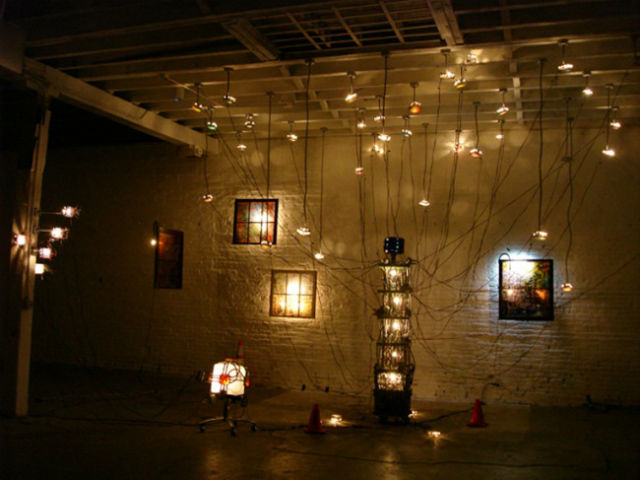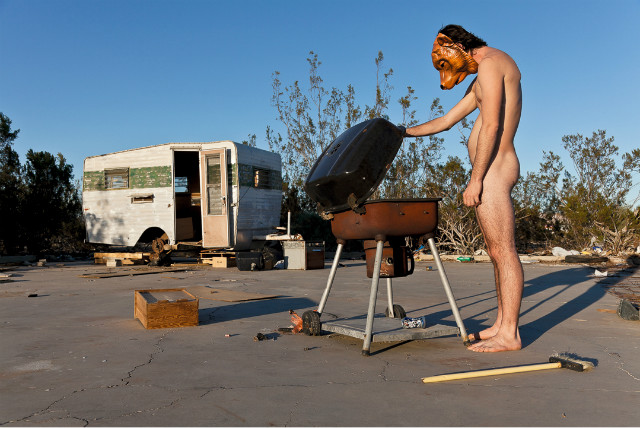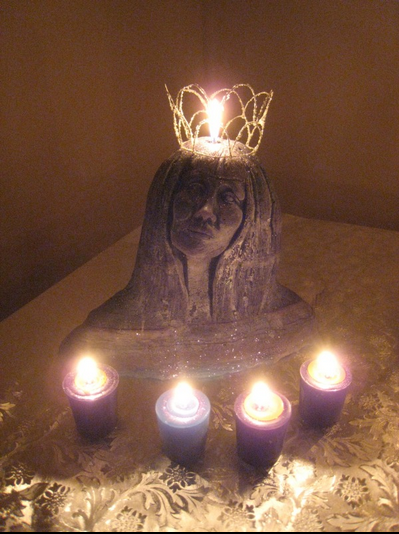When the Brooklyn Museum announced GO, a chance for artists in Brooklyn to share their work with the public and win a chance to exhibit at the museum, I got pretty excited. I’m British, and have only been in New York for under three months, so it seemed like a good chance to get introduced to the local arts scene. Chelsea can only tell a critic so much about artists in New York.
Despite my initial excitement, the results were pretty disappointing. Over the GO weekend, I went to open studios in Williamsburg and Greenpoint, to see if I could discover some new work. Can a “community-curated” project like GO really work? My experiences pointed towards no. My main qualm: there wasn’t an efficient way to find art I might like. Here’s a sampling of what I saw:
Amy Finkbeiner
Things we’re sick of seeing in art (even in London): the Virgin Mary, skulls, cigarettes, and therapy-esque video art. Amy Finkbeiner’s studio was full of all of these things, plus a load of creepy wax candles that lined the floor (I felt like I was about to have aromatherapy upon entering the space).
From the self-photographs of the artist cowering in a corner to pencil drawings of a pregnant Virgin Mary, Finkbeiner had all the tools to make an emotionally charged “woman as goddess” statement, but there was nothing unifying this idea. Finkbeiner’s works on video were more cohesive, however. Repeating “I love myself, I hate myself”, and “Why am I so ANGRY?” over and over again into a video camera, Finkbeiner created a modern day mantra; externalising the internal monologue of “woman” into a chant. It isn’t anything new, feminist artists were making performance art that openly expressed their emotions in 60s, but at least this work made sense.
CCYD

Greenpoint Tree 2007, collaboration with Yevgenia Davidoff and Jeff Hickey. Installation.
CCYD are Carlos F. Carrillo Jr. and partner Yevgenia Davidoff. They work together to make site-specific installations using an array of technology: exposed wires, bolts, TV screens, and flashing lights. The installations are always shifting, because the artists reuse the parts that make up each sculpture. With flashing bulbs, sound, and video, the environments are completely immersive and feel alive. They are also really pretty, despite the raw industrial materials.
I spoke to Carlos F. Carrillo about his work for a good half an hour, and we talked about the problems between emerging artists and gallery representation. Carrillo felt that the 50% cut that galleries take from their artists was unfair, and so projects like GO provided a free platform for emerging artists to show their work. It made me reconsider GO for a moment: was it an endless stream of sub-par art, or could GO have a positive effects for the minority of good artists out there that were involved?
Zach Hyman

Zach Hyman, Preyground 2011: Slab City, CA With Carrie Shaltz
Zach Hyman went on a road trip with his girlfriend and they took some naked pictures of each other. Then he toured New York and took pictures of some naked people. Then he toured—well, you get the picture. He’s got a studio full of over-glossed photographs that don’t express much past an interest in the cheap thrill of illicit nudity.
Alexandra Rubinstein
Alexandra Rubinstein, If These Genitals Could Talk
Rubinstein’s humourous dildo paintings could be really popular. Everyone needs a painting of a dolphin-shaped vibrator, right?
Rubinstein’s sketches of genitalia remind me a little of Betty Tompkins’s super-detailed dick art, but funnier. By placing a penis/vagina below a pair of nipples, Rubinstein makes her genitalia into an array of smiley faces; in fact i saw a full range of punctuation smileys (:p, :/, :*).
Verdict: As somebody that isn’t immersed in the local arts scene, I found it hard to navigate through GO without any guidance. Unless you have friends with studios, it’d hard to know where to go, and you end up seeing a lot of work that doesn’t interest you. GO is a great idea but it needs reshaping. As AFC’s Whitney Kimball has already told us: GO Brooklyn open studios were just too damn open.



{ 2 comments }
Perhaps the day would have been helped by looking at the artist profiles beforehand?
AFC Staff published 9 interviews last week with artists we found looking through the Go website. Leighann was intimately involved in that process. So, no, it didn’t help.
Comments on this entry are closed.
{ 1 trackback }